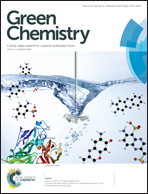Selective conversion of lignin in corncob residue to monophenols with high yield and selectivity†
Abstract
The conversion of lignin to monophenols is regarded as a promising approach to produce high-quality biofuel from renewable feedstocks, because of the higher H/Ceff of lignin than that of cellulose and hemicellulose. In this work, the selective conversion of lignin in corncob residue to monophenols was achieved via a two-step process without significant degradation of cellulose. In the first step, the lignin component in corncob residue was selectively degraded to oligomers in the H2O–tetrahydrofuran (THF) (3 : 7, v/v) co-solvent system, and the percentage of delignification reached up to 89.8%. Further reaction of the filtrate in the THF solvent led to further depolymerization of oligomers to monophenols, and the yield of total monophenols reached up to 24.3 wt% without hydrogen addition under the optimized conditions. 4-Ethylphenol (10.5 wt%), 2,6-dimethoxyphenol (6.6 wt%), and 4-ethylguaiacol (4.0 wt%) were the predominant products, which occupied 86.8% of the identified monophenols. This approach achieved high yield and selectivity to monophenols directly from corncob residue, simplifying the separation process. The obtained reaction residue with high content of cellulose (83.5%) is possibly a preferable feedstock to produce biofuel such as ethanol by fermentation.


 Please wait while we load your content...
Please wait while we load your content...